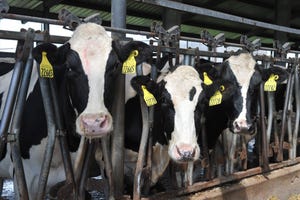Beef cattle market poised to see price swings in 2017
THE U.S. cattle markets have enjoyed a roller-coaster ride over the last six years as cattle prices moved higher and higher, which was followed by a sharp decline over the last 18 months.
December 2, 2016

*Chris Prevatt is a livestock and forage economist with the University of Florida's Range Cattle Research & Education Center.
THE U.S. cattle markets have enjoyed a roller-coaster ride over the last six years as cattle prices moved higher and higher, which was followed by a sharp decline over the last 18 months.
Cattle prices have been supported by a declining U.S. beef cow herd and strong beef demand. The record-setting droughts in 2011 and 2012 forced U.S. beef cow herd liquation, leading to smaller supplies of beef.
U.S. beef demand has enjoyed moderate growth during the last several years despite a slow U.S. economic recovery. The turning point in the U.S. cattle industry occurred on Jan. 1, 2015, when the U.S. Department of Agriculture showed its first year-over-year increase in cow inventories since 2005.
With the breeding herd entering the expansion phase of the cattle cycle, beef production began increasing in late 2016. Assuming adequate moisture conditions, above-average forage production, lower feed costs and positive profit margins, herd expansion then could be expected to continue for the next few years. However, as herd expansion continues, a transition to cyclically lower cattle prices on an annual basis should begin.
The 2017 cattle market will likely experience lower annual average cattle prices compared with 2016 due to increases in net beef supply and domestic competing meat production and weaknesses in the U.S. economy. Decreases in cattle market prices should moderate and not be as precipitous as the decreases experienced during 2016 and the second half of 2015.
Volatile price movements in either direction are still possible, with abrupt changes possible in levels of meat production, beef demand, trade issues and other economic variables.
Despite the moderate growth in beef demand in the last few years, domestic beef demand is expected to be tested during 2017 as significant production increases in beef and competing meats are realized.
Additionally, consumers are expected to begin facing rising interest rates and prices for most goods and services. If consumer disposable income does not rise proportionally, shopping habits and choices will shift, forcing consumers to substitute and/or reduce the bundle of goods and services they have consumed in the past.
U.S. cattle inventory numbers are currently surveyed once per year by USDA every Jan. 1. U.S. cattle producers reported their current cattle inventory numbers to USDA as of Jan. 1, 2016, and this information was published in the "Cattle" report. U.S. cattle producers have increased most categories of their inventory of cattle and calves.
The major factors responsible for causing cattle inventory increases include a combination of higher cattle prices, improved grazing conditions, lower production costs (feed, fertilizer, fuel, etc.) and record profits received from 2013 to 2015.
In the Jan. 1, 2016, survey, cattle producers told USDA that about 1.4 million (2.7%) more cows had calved than the prior year. Beef cows that had calved totaled 30.3 million head, up 1.03 million head (3.5%) from the prior year. Dairy cows that had calved increased about 8,000 head from the previous year to 9.32 million head (0.1%). Beef cow replacements increased about 199,000 head from the previous year to 6.3 million head (3.3%), and dairy cow replacements were up 114,000 head (2.4%) to 4.8 million head.
An increase in total cows (1.04 million head of beef and dairy cows) and total replacements (313,000 head of beef and dairy cows) between January 2015 and January 2016 documents that robust herd expansion is underway in the U.S. cattle industry.
A larger inventory of cattle and calves and a larger calf crop during 2016 are expected to result in higher levels of beef production during 2017. USDA projects U.S. beef production during 2016 to be about 24.9 billion lb., which would be a 5.3% increase from the 2015 estimate of 23.7 billion lb. This level of beef production will be influenced by any adjustments in average carcass weights and the level of feeder and live cattle imports (from Canada and Mexico). Due to significantly cheaper feedstuffs, slaughter weights should continue to be heavier during 2016 and 2017.
The supplies of beef, broilers and pork are expected to respond quickly to changes in demand. Each industry is very capable of significantly altering production levels and is subject to wide changes in export and import levels. Any significant changes in domestic demand and/or foreign demand of these three competing meats could cause major movements in beef prices. U.S. meat production of beef, broilers and pork in 2016 is expected to increase to 90.7 billion lb. — 2.5 billion lb., or 2.8%, more than 2015.
2017 production
Likewise, 2017 U.S. meat production of beef, broilers and pork is expected to increase to 93.3 billion lb., which is 2.6 billion lb., or 2.8%, more than 2016.
The 2015-17 U.S. net beef supply estimates are shown in the Table. The U.S. net beef supply is domestic beef production plus beef imports minus beef exports. The net beef supply is the amount of beef that is consumed in U.S. markets. The 2016 U.S. net beef supply is expected to show an increase of about 600 million lb. (25.437 billion - 24.804 billion = 633 million), or 2.55%, compared with 2015. The 2017 U.S. net beef supply is expected to show an increase of roughly 400 million lb. (25.820 billion - 24.437 billion = 383 million), or 1.55%, compared with 2016.
Minor changes in future U.S. beef import and/or export levels (due to beef demand, food safety, exchange rates, politics, regulations, etc.) can significantly change the U.S. net beef supply and, consequently, domestic beef prices.
Additionally, the strength of the U.S. dollar will have a major influence on the levels of U.S. beef exports and imports during 2017. If the U.S. dollar has a stronger value versus the currencies of trading partners, expect fewer U.S. beef exports to these countries and more lean beef imports into the U.S.
The total 2015 U.S. net supply of beef, broilers and pork increased about 2.7 billion lb. (3.7%) from 2014. Likewise, the 2016 U.S. net supply of beef, broilers and pork is expected to increase about 2.3 billion lb. (2.9%) compared with 2015. The 2016 U.S. net broiler supply is expected to increase 900 million lb. (2.8%), net pork supplies are expected to increase 400 million lb. (2.4%) and the net beef supply is expected to increase 800 million lb. (3.2%). The increased supplies of beef and competing meats will likely limit beef prices during 2017.
The Figure describes U.S. beef as a percentage of total U.S. beef, broiler and pork net supply between 2005 and 2017. U.S. beef as a percentage of total U.S. beef, broiler and pork net supply has ranged between 31.3% and 36.3% during the 13 years evaluated.
The trend line shows that U.S. beef as a percent of U.S. net supply is decreasing over time. In order to reverse this trend, a combination of actions will be necessary to encourage future increased beef production, such as increased cattle and forage performance, lower production costs, favorable weather for forage production, improved consumer beef demand and reasonable profits.
Prices
Any changes in these production, import and/or export levels of pork and broilers could have a significant effect on U.S. beef prices. Additionally, any further increases/decreases in feedstuff prices will likely alter these production projections.
A watchful eye on the production and export levels of competing meats and feed prices will help identify potential changes in beef prices.
Factors to watch in 2017 that affect U.S. cattle markets include the growth of the U.S. economy, levels of unemployment, consumer confidence, domestic and international beef demand, input prices, exchange rates, interest rates, energy prices, levels of competing meats, adverse weather events and outliers (food safety, war, terrorist incidents, etc.). Any significant movement of one or some combination of these factors is believed to have an overwhelming effect on U.S. business and consumer spending as well as on cattle prices.
The Bottom Line
The 2017 cattle market has the potential for some big price swings, as should be expected. Abrupt changes in the levels of the factors mentioned above could add more volatility to 2017 cattle market prices. As the cattle cycle continues to move forward, a transition to cyclically lower cattle prices on an annual basis is expected.
Therefore, cattle producers will need to search for ways to lower their unit cost of production (what it costs to produce a pound of beef) and opportunities to enhance market prices in order to achieve adequate levels of profitability during 2017.
U.S. net beef supply (billion lb.) |
Item |
U.S. domestic beef production |
U.S. beef and veal imports |
U.S. beef and veal exports |
U.S. net beef supply* |
*USDA estimates reported as of Sept. 16, 2016. |
Note: Columns may not sum exactly due to rounding. |

Volume:88 Issue:12
You May Also Like



